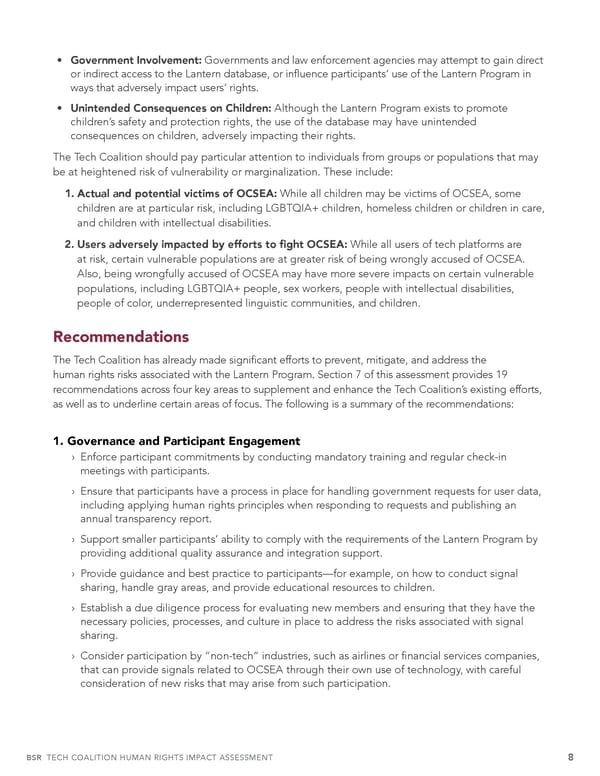• Government Involvement: Governments and law enforcement agencies may attempt to gain direct or indirect access to the Lantern database, or in昀氀uence participants’ use of the Lantern Program in ways that adversely impact users’ rights. • Unintended Consequences on Children: Although the Lantern Program exists to promote children’s safety and protection rights, the use of the database may have unintended consequences on children, adversely impacting their rights. The Tech Coalition should pay particular attention to individuals from groups or populations that may be at heightened risk of vulnerability or marginalization. These include: 1. Actual and potential victims of OCSEA: While all children may be victims of OCSEA, some children are at particular risk, including LGBTQIA+ children, homeless children or children in care, and children with intellectual disabilities. 2. Users adversely impacted by efforts to 昀椀ght OCSEA: While all users of tech platforms are at risk, certain vulnerable populations are at greater risk of being wrongly accused of OCSEA. Also, being wrongfully accused of OCSEA may have more severe impacts on certain vulnerable populations, including LGBTQIA+ people, sex workers, people with intellectual disabilities, people of color, underrepresented linguistic communities, and children. Recommendations The Tech Coalition has already made signi昀椀cant efforts to prevent, mitigate, and address the human rights risks associated with the Lantern Program. Section 7 of this assessment provides 19 recommendations across four key areas to supplement and enhance the Tech Coalition’s existing efforts, as well as to underline certain areas of focus. The following is a summary of the recommendations: 1. Governance and Participant Engagement › Enforce participant commitments by conducting mandatory training and regular check-in meetings with participants. › Ensure that participants have a process in place for handling government requests for user data, including applying human rights principles when responding to requests and publishing an annual transparency report. › Support smaller participants’ ability to comply with the requirements of the Lantern Program by providing additional quality assurance and integration support. › Provide guidance and best practice to participants—for example, on how to conduct signal sharing, handle gray areas, and provide educational resources to children. › Establish a due diligence process for evaluating new members and ensuring that they have the necessary policies, processes, and culture in place to address the risks associated with signal sharing. › Consider participation by “non-tech” industries, such as airlines or 昀椀nancial services companies, that can provide signals related to OCSEA through their own use of technology, with careful consideration of new risks that may arise from such participation. BSR TECH COALITION HUMAN RIGHTS IMPACT ASSESSMENT 8
 Tech Coalition Human Rights Impact Assessment of the Lantern Program Page 7 Page 9
Tech Coalition Human Rights Impact Assessment of the Lantern Program Page 7 Page 9